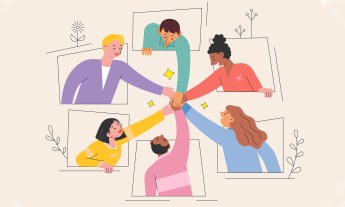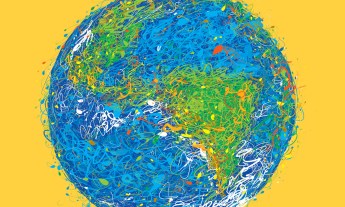
How can nonprofits, social entrepreneurs and individuals join forces to impact the future? TED Curator Chris Anderson unveils an exciting new collaboration to fund bold ideas.
For the past three years, a group of foundations and individuals has been working with TED to design a new model for turning bold ideas into action. It’s been tried and tested, and it’s already delivering exciting results. With today’s announcement, we’d like to share our thinking behind this initiative and open the doors for others to participate.
Large-scale change depends to a huge degree on people with a special mindset: entrepreneurs. They have the ability to imagine a better future and the courage, ingenuity, persuasiveness and determination to make that future real. Entrepreneurs can choose one of two main paths: for-profit (business entrepreneurs) or nonprofit (social entrepreneurs). In today’s world, those two paths will take them on radically different journeys.
A tale of two different entrepreneurs with world-changing ideas
Meet Marcus — he’s a passionate young entrepreneur with a proven track record, and he has a vision for an innovative service called Loan Me. Loan Me would offer instant cash for impulse purchases based on an algorithm that cleverly analyzes a person’s credit rating. Marcus dreams that it could appeal to millions of people around the world. Attracting investors is never easy, of course, but the profitable business model eventually allows him to generate buzz among venture capitalists who back him with three rounds of funding totaling $25 million, using funds that pool dollars from dozens of early-stage investors. Three years later, he takes his company public, bringing in another $75 million in a single day from thousands of new investors. Barely two years after that, his company is reaching 30 million customers. Marcus is a multi-millionaire, and his investors and shareholders have made their mark.
Not everything the world needs can be turned into a profitable product, however. Three blocks away in the same city lives Maya. She too is a passionate young entrepreneur with a proven track record and also has a vision for an innovative service called Lean on Me. Lean on Me would offer an immediate financial lifeline to people hit by a personal crisis, plus connect them to trained volunteers for emotional support and guidance. Maya dreams that it could appeal to millions of people around the world and could save them from the terrible downward spiral in which a single disaster can plunge a family into poverty. But there’s a key challenge she has to overcome: the people she’s looking to support don’t have any money. They could eventually pay back a loan … but far more slowly than traditional lenders would allow. Governments and employers might pick up the cost of her service, but it will take many years to persuade them. Maya’s only way forward is to set up a nonprofit so that her service can be subsidized philanthropically. Her business plan indicates that to get to scale, she will have to invest $100 million over five years. How does she raise that money?
For nonprofit efforts like Maya’s, there are no venture capitalists she can approach. There is no equivalent of an IPO in her future. What she must do is approach a range of foundations and individual philanthropists, one at a time. And even when she can get a meeting, every potential funder encourages her to move in a slightly different direction before they’ll give support. Three years later, she has been able to accumulate only a fraction of the investment she needs. Maya gets burned out. To save her sanity, she cuts back her ambitions. Instead of helping people around the world, she finds a funder willing to subsidize the service for people in her home city, provided she rebrands it to include the donor’s name. She takes comfort from the fact that over the following years several hundred local people will benefit from her service. Sadly, the chance to get to real operational efficiency cannot be realized at this scale, and millions of others around the world will suffer their crises alone, never knowing that someone like Maya was willing to lend a hand.
Why do these entrepreneurs end up with such different outcomes?
There is no inherent reason why nonprofit initiatives can’t generate change at massive scale. While they may not be able to fund their work through making a profit, there are still multiple ways they can tap into the power of the global economy, the support of the government, or the reach of the Internet.
But here’s the key problem: Nonprofit fundraising is fundamentally harder. The resources that for-profits have for raising big, multi-year investments — VCs, major bank loans, stock markets — aren’t available. Nonprofit initiatives are too often funded one donor at a time, one year at a time. It’s a deeply inefficient and endlessly frustrating process.
It’s not just the social entrepreneurs who are frustrated. Private donors — many of whom have gained unprecedented personal wealth in recent years — dread the endless cycle of fundraising pitches. While they might aspire to do world-changing work through their philanthropy, there isn’t a ready market for breakthrough ideas that they can tap into. It can seem risky to fund projects, as well as time-consuming. In fact, time is often the biggest single constraint. So it’s no surprise that many with the means and the heart to give big end up doing less than they dream of doing. And it’s why some of the world’s best-positioned changemakers, both doers and funders, feel forced to give up on their biggest dreams, and the possibility of creating truly audacious change is left underexplored. What could we do about that?
Our proposal to solve the problem
Many people and organizations have recognized this impasse. In the past few years, we’ve seen several new and exciting ways to address it, including Blue Meridian Partners, the Co-Impact initiative, and MacArthur Foundation’s 100&Change program. They share a belief in the power of pooling significant, long-term resources to accelerate solutions to our world’s greatest challenges.
A group of us would like to contribute another concept to the list. We’re calling it “The Audacious Project: Collaborative Philanthropy for Bold Ideas.” It’s the result of four years of dreaming and experimentation with an extraordinary group of collaborators. They include Jeff Skoll, Sir Richard Branson, Laurene Powell Jobs, Scott Cook, Ray Dalio, Tom Tierney and Dan Pallotta, to name just a few, not to mention years of conversations with Jacqueline Novogratz, the extraordinary change-maker I’m married to, and an inspiring journey with my colleague Anna Verghese and the TED Prize team.
The core idea of The Audacious Project is to do three things simultaneously in order to spark change at scale. You can think of it as an attempt to imagine what an IPO for the nonprofit world might look like, or simply as a thrilling way for private individuals to pool resources and work together in the service of entrepreneurs who could change the world. Here are the three key steps:
1) Invite some of the world’s greatest change agents to dream like they’ve never dreamed before and create ideas that are truly audacious. These ideas might impact millions or even hundreds of millions of people, impact our environment at a planetary scale, or transform science and our long-term prospects of survival and flourishing.
2) Vet the ideas to find those which genuinely offer a path to execution, scale and impact. Select the best and help shape them into actionable, multi-year plans that are both viable and sustainable.
3) Present them to the world in a single moment that provides as much visibility and excitement as possible, and invite people to support them … together. Use the momentum generated by the occasion to build a community of committed supporters for each project who will sustain it over multiple years, contributing ideas, time, influence and, of course, money, and be true partners in their success.
Taken together, the three steps should create an exciting marketplace for bold, fundable ideas — but can this approach actually work? Yes. We have already piloted this process twice, beginning in 2015. Each time, our TED Prize team researched hundreds of possible ideas, distilled them to a handful that were both exciting and credible, and presented them to small groups of well-resourced donors.
Both times, the result was extraordinary: many of the projects inspired major financial investments. In all, more than $250 million was committed to the inaugural projects, exceeding our wildest expectations. Even better, the process itself was inspiring — both to the organizations who created the projects and to the individual donors who had the opportunity to work together in service of these big ideas.
Please join as we launch The Audacious Project
Now we believe it’s time to expand The Audacious Project, so that anyone in the world can participate. A remarkable group of organizations and individuals has joined forces with us at TED to make this possible. They include the Skoll Foundation, Virgin Unite, Scott Cook & Signe Ostby, the Dalio Foundation, Laura & John Arnold, ELMA Philanthropies, the John D. and Catherine T. MacArthur Foundation, the Bill & Melinda Gates Foundation, the Bridgespan Group and others.
On April 11, 2018, we’ll unveil the plan simultaneously at the TED Conference and at the Skoll World Forum. We’ll present five projects that we discovered during our pilot phase. They’ve all gone through an intense due diligence process, engaged with donors, and received significant financial commitments. The five projects range from ocean exploration and climate change remediation to rethinking criminal justice, empowering communities and expanding public health. Their inspiring creators will share their dreams in the form of short TED Talks, and we invite everyone to join those who’ve already committed themselves to helping make their dreams real. In addition, we’ve allocated $1 million for TED2018 attendees to distribute among the projects — and we’ll encourage attendees to vote on how they would like their share to be contributed. That day, at the Audacious Project website, we’ll also add the ability for anyone, anywhere to support these ideas and find out how they can make a difference.
The website will offer the ability for any change-maker or change-making organization to pitch their own idea for impact at scale and detail how they could execute it given the appropriate financial support. We expect many projects in the $25 million to $50 million range. However, some projects might need funding that exceeds $100 million, or perhaps even many times that sum. Whatever the amount, the money will be effectively used to accomplish something truly amazing. From our experience, we anticipate that most of the successful projects will come from existing, proven organizations that are ready for a whole new level of ambition. But we’re open to ideas from individual change-makers who have stellar track records, as well as ideas from multiple organizations that are teaming up and proposing a major collaboration (provided their respective roles are clear). Anyone is welcome to apply and make their case.
The only fundamental rules are: Dream big. And then show us how that dream can come true. The proposals will be narrowed down to a few dozen that will go through significant due diligence, as we look for those that best combine audacity with feasibility. From this year forward, the five most compelling projects will be presented annually at the TED Conference.
Maya, are you listening? This is for you! Instead of hundreds of meetings, you might be able to fund your beautiful dream in a single burst.
Marcus, this might be for you, too! Part of the fortune you’ve made could be reinvested for the public good, in credible, vetted ideas that are every bit as bold and entrepreneurial as you are and that bring you together with other visionary funders.
As for you, dear reader, this truly is for you as well. The Audacious Project is something that we can all participate in. Yes, the scale of funding required for these projects is way out of reach to most individuals — but that’s the whole point. This is intended to be a way to pool our efforts. We strongly believe a shared focus on large-scale initiatives is likely to have far more impact than fragmented efforts by siloed individuals.
Here’s why scale matters
Scale brings with it all manner of efficiencies, leverage, brand visibility and network effects. With scale, you can build a platform, attract partners, and reach critical mass. Even a small contribution to such an effort is likely to achieve more than the same money spent elsewhere — it’s helping accelerate a train that is already moving and making it unstoppable.
What’s more, it is not just your money that can help: it’s also your ideas, your encouragement and your ability to spread the word. All of the projects will need and benefit from a committed community of supporters, cheering them on through thick and thin. The Audacious Project will be housed at TED under the leadership of Executive Director Anna Verghese. A ten-year TED employee, she has been the TED Prize Director for the last five years and has built a team whose purpose is to track down the world’s most inspiring change-makers. Now that team is being expanded to take on a much bigger project, replacing the TED Prize with something anchored in the same values but vastly more ambitious. The Bridgespan Group, a leading global social impact advisory firm, is playing a key role in supporting the collaboration and working with entrepreneurs to create investment-ready plans
This initiative will face numerous challenges. Some of the audacious plans we back may fail, just as many venture-backed investments do. Indeed, if none of them fail, we probably aren’t taking enough risk. But if and when we do fail, we’ll fail together. And we’ll learn together.
And what if we succeed? We believe there’s a chance that something transformative could happen, even beyond the direct impact of the projects. There’s a chance that some of the world’s change-makers may be encouraged to dream more creatively and more boldly than ever before, to truly explore what humanity is capable of. We may be amazed at what they come up with.
We invite you to witness the launch of the Audacious Project firsthand. We’ll be livestreaming this special session at next week’s TED Conference — it will be at 5pm PST on April 11, 2018. Watch and be part of a global community of changemakers, seeing the first projects that we share. If you feel inspired, you will have a chance to become a founding supporter of one of them, to help create meaningful impact, and to be part of something bigger than any of us.
So are you ready for a little hope? Come join!














